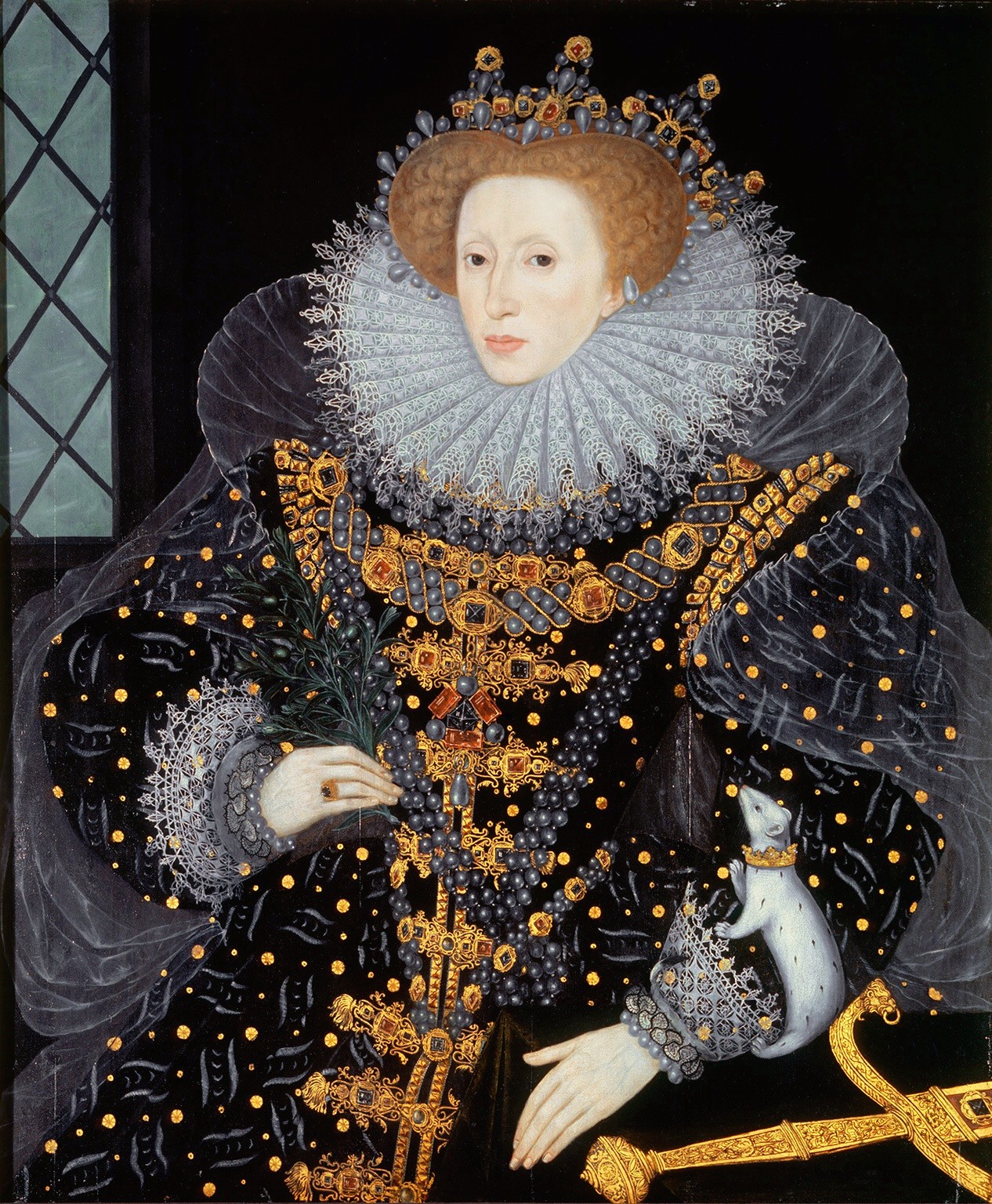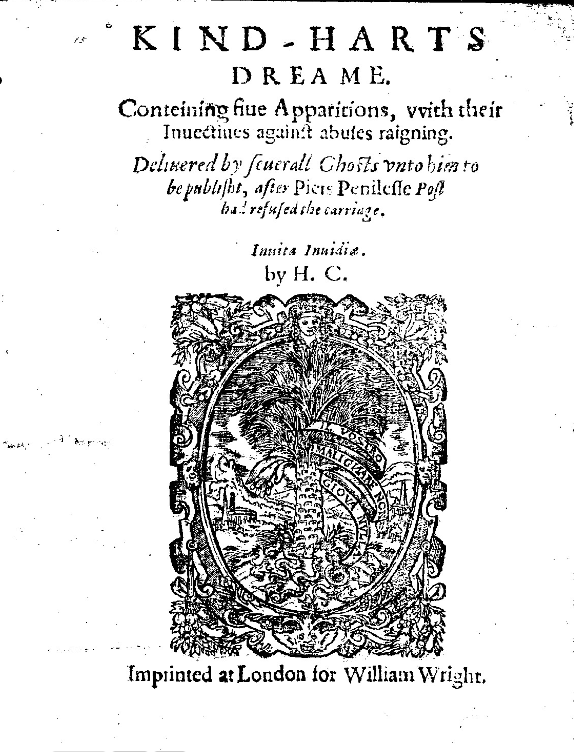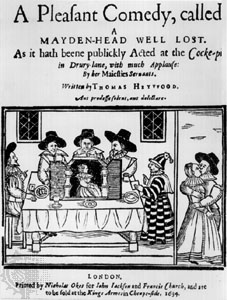|
Worcester's Men
The Earl of Worcester's Men was an acting company in Renaissance England. An early formation of the company, wearing the livery of William Somerset, 3rd Earl of Worcester, is among the companies known to have toured the country in the mid-sixteenth century. A later iteration of the company toured through the 1580s and '90s; little is known about its activities, though in 1583 it included the sixteen-year-old Edward Alleyn, at the start of his illustrious career. By the start of the seventeenth century, Edward Somerset, 4th Earl of Worcester was moving up into the higher levels of the late-Elizabethan social and political structure; in April 1601 he became the Queen's Master of the Horse. It was to add to his prestige that Worcester wanted to bring his players to London. Through the 1590s, only two companies of adult players, the Lord Chamberlain's Men and the Admiral's Men, had been officially allowed in London. Worcester was able to make his company the third, with a license ... [...More Info...] [...Related Items...] OR: [Wikipedia] [Google] [Baidu] |
English Renaissance
The English Renaissance was a Cultural movement, cultural and Art movement, artistic movement in England from the early 16th century to the early 17th century. It is associated with the pan-European Renaissance that is usually regarded as beginning in Italy in the late 14th century. As in most of the rest of northern Europe, England saw little of these developments until more than a century later. Renaissance style and ideas, however, were slow to penetrate England, and the Elizabethan era in the second half of the 16th century is usually regarded as the height of the English Renaissance. However, many scholars see its beginnings in the early 16th century, during the reign of Henry VIII. The English Renaissance is different from the Italian Renaissance in several ways. The dominant art forms of the English Renaissance were literature and music. Visual arts in the English Renaissance were much less significant than in the Italian Renaissance. The English period began far later than ... [...More Info...] [...Related Items...] OR: [Wikipedia] [Google] [Baidu] |
Henry Chettle
Henry Chettle (c. 1564 – c. 1606) was an English dramatist and miscellaneous writer of the Elizabethan era, best known for his pamphleteering. Early life The son of Robert Chettle, a London dyer, he was apprenticed in 1577 and became a member of the Stationer's Company in 1584, traveling to Cambridge on their behalf in 1588. His career as a printer and author is shadowy. He may have set up some of the tracts printed in response to Martin Marprelate. In 1591, he entered into partnership with William Hoskins and John Danter, two stationers. They published a good many ballads, and some plays, including a surreptitious and botched first quarto of ''Romeo and Juliet'', to which it is suggested Chettle added lines and stage directions. ''The Groat's-Worth of Wit'' In 1592 ''Greene's Groats-Worth of Wit'', supposedly the work of the recently deceased, and very popular, Robert Greene, was published, having been entered in the register of the Stationer's Company "at the peril of H ... [...More Info...] [...Related Items...] OR: [Wikipedia] [Google] [Baidu] |
Edmund Kerchever Chambers
Sir Edmund Kerchever Chambers, (16 March 1866 – 21 January 1954), usually known as E. K. Chambers, was an English literary critic and Shakespearean scholar. His four-volume work on ''The Elizabethan Stage'', published in 1923, remains a standard resource. Life Chambers was born in West Ilsley, Berkshire. His father was a curate there and his mother the daughter of a Victorian theologian. He was educated at Marlborough College, before matriculating at Corpus Christi College, Oxford. He won a number of prizes, including the chancellor's prize in English for an essay on literary forgery in 1891. He took a job with the national education department, and married Eleanor Bowman in 1893. In the newly created Board of Education, Chambers worked principally to oversee adult and continuing education. He rose to be second secretary, but the work for which he is remembered took place outside the office, at least before he retired from the Board in 1926. He was the first president of ... [...More Info...] [...Related Items...] OR: [Wikipedia] [Google] [Baidu] |
Queen Anne's Men
Queen Anne's Men was a playing company, or troupe of actors, in Jacobean era London. In their own era they were known colloquially as the Queen's Men — as were Queen Elizabeth's Men and Queen Henrietta's Men, in theirs. Formation The group was formed on the accession of James I in 1603, and named after its patron, James's wife Anne of Denmark. It was a combination of two previously-existing companies, Oxford's Men and Worcester's Men. Among the company's most important members were Christopher Beeston, its manager, and Thomas Heywood, the actor-dramatist who wrote many of its plays, including ''The Rape of Lucrece'' (printed 1608) and ''The Golden Age'' (printed 1611). William Kempe finished his career with this company, though he died c. 1603. Personnel In 1604, ten members of the new-formed company were granted the sum of four and a half pounds each, to buy red cloth for their livery for 15 March coronation procession. The ten were Beeston, Heywood, Richard Perkins ... [...More Info...] [...Related Items...] OR: [Wikipedia] [Google] [Baidu] |
James VI And I
James VI and I (James Charles Stuart; 19 June 1566 – 27 March 1625) was King of Scotland as James VI from 24 July 1567 and King of England and Ireland as James I from the union of the Scottish and English crowns on 24 March 1603 until his death in 1625. The kingdoms of Scotland and England were individual sovereign states, with their own parliaments, judiciaries, and laws, though both were ruled by James in personal union. James was the son of Mary, Queen of Scots, and a great-great-grandson of Henry VII, King of England and Lord of Ireland, and thus a potential successor to all three thrones. He succeeded to the Scottish throne at the age of thirteen months, after his mother was compelled to abdicate in his favour. Four different regents governed during his minority, which ended officially in 1578, though he did not gain full control of his government until 1583. In 1603, he succeeded Elizabeth I, the last Tudor monarch of England and Ireland, who died childless. He ... [...More Info...] [...Related Items...] OR: [Wikipedia] [Google] [Baidu] |
Globe Theatre
The Globe Theatre was a theatre in London associated with William Shakespeare. It was built in 1599 by Shakespeare's playing company, the Lord Chamberlain's Men, on land owned by Thomas Brend and inherited by his son, Nicholas Brend, and grandson, Sir Matthew Brend, and was destroyed by fire on 29 June 1613. A second Globe Theatre was built on the same site by June 1614 and stayed open until the London theatre closures of 1642. A modern reconstruction of the Globe, named "Shakespeare's Globe", opened in 1997 approximately from the site of the original theatre.Measured using Google earth Locations Examination of old property records has identified the plot of land occupied by the Globe as extending from the west side of modern-day Southwark Bridge Road eastwards as far as Porter Street and from Park Street southwards as far as the back of Gatehouse Square. The precise location of the building remained unknown until a small part of the foundations, including one original p ... [...More Info...] [...Related Items...] OR: [Wikipedia] [Google] [Baidu] |
A Woman Killed With Kindness
A'' Woman Killed with Kindness'' is an early seventeenth-century stage play, a tragedy written by Thomas Heywood. Acted in 1603 and first published in 1607, the play has generally been considered Heywood's masterpiece, and has received the most critical attention among Heywood's works. Along with the anonymous ''Arden of Faversham,'' Heywood's play has been regarded as the apex of Renaissance drama's achievement in the subgenre of bourgeois or domestic tragedy. The play was originally performed by Worcester's Men, the company for which Heywood acted and wrote in the early Jacobean era. The records of Philip Henslowe show that Heywood was paid £6 for the play in February and March 1603. The 1607 quarto was printed by William Jaggard for the bookseller John Hodgets. A second quarto was issued in 1617 by William Jaggard's son Isaac Jaggard. The plot of Heywood's play derives from an Italian novel by Illicini, which was translated into English and published in ''The Palace of Pleasure ... [...More Info...] [...Related Items...] OR: [Wikipedia] [Google] [Baidu] |
King's Men Personnel
King's Men personnel were the people who worked with and for the Lord Chamberlain's Men and the King's Men (for all practical purposes a single continuous theatrical enterprise) from 1594 to 1642 (and after). The company was the major theatrical enterprise of its era and featured some of the leading actors of their generation – Richard Burbage, John Lowin, and Joseph Taylor among other – and some leading clowns and comedians, like Will Kempe and Robert Armin. The company benefitted from the services of William Shakespeare, John Fletcher, and Philip Massinger as regular dramatists. The actors who performed the plays have left the most evidence of their lives and activities; but they were supported by musicians and other functionaries, and were enabled by managers and financial backers like Cuthbert Burbage. For more information on specific individuals, see individual entries: Robert Armin, Christopher Beeston, Robert Benfield, etc. Terms * "Sharer" – an actor who was ... [...More Info...] [...Related Items...] OR: [Wikipedia] [Google] [Baidu] |
Christopher Beeston
Christopher Beeston (c. 1579 – c. 15 October 1638) was a successful actor and a powerful theatrical impresario in early 17th century London. He was associated with a number of playwrights, particularly Thomas Heywood. Early life Little is known of Beeston's early life. In extant records he is known alternately as Beeston and Hutchison. He has not so far been decisively connected with the William Beeston mentioned by Thomas Nashe in ''Strange News''; however, such a connection is possible. Beeston has been conjecturally associated with the "Kit" in the surviving plot of Richard Tarlton's ''The Seven Deadly Sins''. It is likely that he began in theatre as a child actor: Augustine Phillips bequeathed "his servant" Beeston thirty shillings in his 1605 last will and testament, indicating that Beeston had been that actor's apprentice with the Lord Chamberlain's Men. Beeston played in the company's 1598 production of Ben Jonson's ''Every Man in His Humour''. So it appears that Beesto ... [...More Info...] [...Related Items...] OR: [Wikipedia] [Google] [Baidu] |
William Kempe
William Kempe (c. 1560–c. 1603), commonly referred to as Will Kemp, was an English actor and dancer specialising in comic roles and best known for having been one of the original players in early dramas by William Shakespeare. Roles associated with his name may include the great comic creation, Falstaff, and his contemporaries considered him the successor to the great clown of the previous generation, Richard Tarlton. Kempe's success and influence was such that in December 1598 he was one of a core of five actor-shareholders in the Lord Chamberlain's Men alongside Shakespeare and Richard Burbage, but in a short time (possibly after a disagreement among the members of the troupe) he parted company with the group. Despite his fame as a performer and subsequent intent to continue his career, he appears to have died unregarded and in poverty circa 1603. Life In a 1615 lawsuit brought by Thomasina (née Heminges) Ostler, widow of William Ostler, against her father, John Heminges, ... [...More Info...] [...Related Items...] OR: [Wikipedia] [Google] [Baidu] |
Thomas Heywood
Thomas Heywood (early 1570s – 16 August 1641) was an English playwright, actor, and author. His main contributions were to late Elizabethan and early Jacobean theatre. He is best known for his masterpiece ''A Woman Killed with Kindness'', a domestic tragedy, which was first performed in 1603 at the Rose Theatre by the Worcester's Men company. He was a prolific writer, claiming to have had "an entire hand or at least a maine finger in two hundred and twenty plays", although only a fraction of his work has survived. Early years Few details of Heywood's life have been documented with certainty. Most references indicate that the county of his birth was most likely Lincolnshire, while the year has been variously given as 1570, 1573, 1574 and 1575. It has been speculated that his father was a country parson and that he was related to the half-century-earlier dramatist John Heywood, whose death year is, again, uncertain, but indicated as having occurred not earlier than 1575 and n ... [...More Info...] [...Related Items...] OR: [Wikipedia] [Google] [Baidu] |
John Lowin
John Lowin (baptized 9 December 1576 – buried – 24 August 1653) was an English actor. Early life Born in St Giles-without-Cripplegate, London, Lowin was the son of a tanner. Like Robert Armin, he was apprenticed to a goldsmith. While he is not recorded as a free citizen of this company, he did perform as a goldsmith, Leofstane, in a 1611 city pageant written by Anthony Munday. This pageant was commissioned by the Goldsmiths' Company in honor of the election of one of their company as mayor; in the document employing him, Lowin is described as a "brother" of the company, suggesting some form of ongoing relationship with that community. He lived in Southwark, where parish registers record two marriages involving a man of his name (in 1607 and 1620); the latter definitely involved the actor. Career Lowin was definitely associated with the theatrical world by 1602. His name frequently occurs in the account books of Philip Henslowe in 1602, when he was playing with Worces ... [...More Info...] [...Related Items...] OR: [Wikipedia] [Google] [Baidu] |






